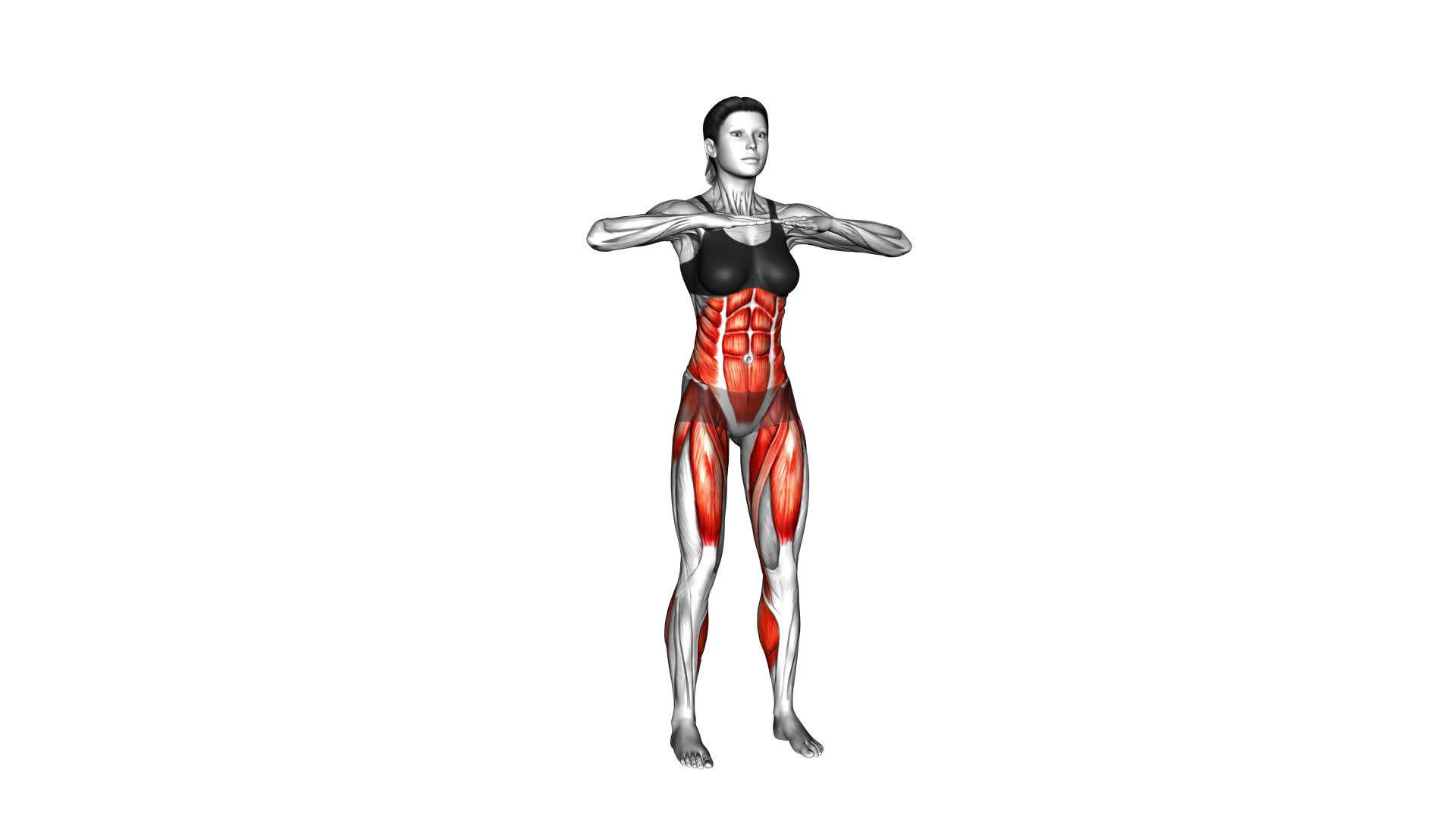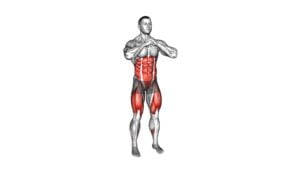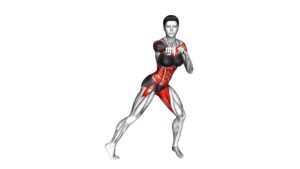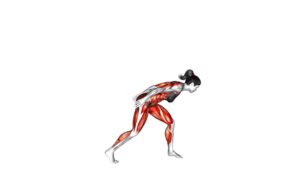Standing Turn and Knee Raise (female) – Video Exercise Guide & Tips

Are you looking for a dynamic exercise that targets your core and strengthens your legs? Look no further than the Standing Turn and Knee Raise!
Watch This Exercise Video
In this video exercise guide, we'll show you step-by-step how to properly perform this exercise, while offering tips to maximize its effectiveness.
With just a few minutes a day, you can incorporate this exercise into your fitness routine and start reaping the benefits.
Get ready to feel the burn and see results!
Key Takeaways
- Increased core strength
- Improved balance
- Engages core muscles, including abdominals and obliques
- Targets hip flexors and leg muscles
Benefits of the Standing Turn and Knee Raise
You will experience increased core strength and improved balance with the Standing Turn and Knee Raise exercise. Proper form is crucial when performing this exercise to maximize its benefits and prevent injury.
The standing turn involves rotating your upper body while maintaining a stable lower body position. This movement engages your core muscles, including the abdominals and obliques, enhancing their strength and stability.
Additionally, the knee raise element targets the hip flexors and leg muscles, further improving your balance and overall lower body strength.
To ensure proper form, start by standing with your feet hip-width apart and your knees slightly bent. As you rotate, keep your hips stable and facing forward, allowing only your upper body to twist. Avoid excessive twisting or jerking motions that may strain your back. Gradually increase the range of motion as your core strength improves. Remember to breathe steadily throughout the exercise and maintain a neutral spine position.
For beginners or those with limited mobility, modifications can be made to adapt the standing turn and knee raise exercise. You can start by performing a smaller range of motion or reducing the speed of the movement. If balance is a concern, you may choose to hold onto a stable surface, such as a chair or wall, for support. As you gain strength and confidence, you can gradually progress to performing the exercise without assistance.
Equipment Needed for the Exercise
To properly perform the Standing Turn and Knee Raise exercise, you'll need a few pieces of equipment. First and foremost, you'll need a sturdy and stable surface to stand on, such as a gym mat or a non-slip floor. This will ensure that you have a solid base to perform the exercise safely and effectively.
Additionally, you'll need a resistance band or a cable machine. The resistance band should be anchored securely to a fixed object, such as a pole or a wall, at chest height. If you're using a cable machine, make sure to adjust the weight and the height of the pulley to your desired level of resistance.
Exercise modifications can be made based on your fitness level and goals. For beginners or those with limited mobility, you can start by performing the exercise without any resistance. As you become more comfortable and stronger, you can gradually increase the resistance by using a heavier band or adjusting the weight on the cable machine.
When performing the Standing Turn and Knee Raise exercise, it's important to maintain proper form. Keep your core engaged and your back straight throughout the movement. Avoid swinging your leg or using momentum to lift it. Instead, focus on using your hip flexors to raise your knee towards your chest in a controlled manner. This will help target the muscles in your hips, thighs, and core effectively.
Step-By-Step Guide to Performing the Standing Turn and Knee Raise
To perform the Standing Turn and Knee Raise exercise, begin by positioning yourself on a sturdy and stable surface. This will ensure that you have a solid base to work from and minimize the risk of injury. Once you're in position, follow these steps to complete the exercise.
- Stand with your feet shoulder-width apart and your arms relaxed at your sides.
- Slowly shift your weight onto your right foot, keeping your core engaged for balance.
- Lift your left knee up towards your chest, while simultaneously rotating your upper body to the left. Your left knee should be at a 90-degree angle.
- Hold this position for a brief moment, then return your left foot to the ground and repeat on the opposite side.
- Continue alternating sides for the desired number of repetitions.
Common Mistakes to Avoid During the Exercise
A common mistake to avoid during the Standing Turn and Knee Raise exercise is failing to maintain proper form and balance.
Proper form is crucial to ensure that you're targeting the correct muscles and minimizing the risk of injury. One common mistake is hunching your back or rounding your shoulders. This not only reduces the effectiveness of the exercise but also puts unnecessary strain on your spine.
To maintain proper form, keep your back straight and your shoulders down and relaxed throughout the movement.
Another common mistake isn't engaging your core muscles. Your core provides stability and support during this exercise, so it's important to actively engage your abdominal muscles throughout the movement.
Additionally, make sure to avoid swinging your leg or using momentum to lift it. This reduces the intensity of the exercise and can potentially lead to strain or injury.
Instead, focus on using your hip flexor muscles to lift your leg in a controlled and deliberate manner.
Tips for Maximizing the Effectiveness of the Standing Turn and Knee Raise
Maximize the effectiveness of the Standing Turn and Knee Raise by focusing on proper technique and engaging your core muscles. To improve balance during this exercise, make sure to maintain a strong and stable stance throughout. Keep your feet hip-width apart and distribute your weight evenly between both legs. This will help you stay grounded and prevent any wobbling or tipping over.
It is also important to engage your core muscles while performing the Standing Turn and Knee Raise. This won't only increase the effectiveness of the exercise, but also help in maintaining proper form. As you lift your knee towards your chest, imagine pulling your belly button towards your spine. This will activate your deep abdominal muscles, providing stability and control.
For beginners, it may be necessary to modify the exercise to ensure proper execution. Start by performing the knee raise without the turn. This will allow you to focus on balance and core engagement without adding the additional challenge of rotation. Once you feel comfortable with the basic movement, gradually introduce the turn, starting with small rotations and gradually increasing the range of motion.
Frequently Asked Questions
How Many Calories Can I Burn by Doing the Standing Turn and Knee Raise?
You can burn a significant number of calories by incorporating the standing turn and knee raise exercise into your routine. This exercise engages multiple muscle groups, resulting in a higher calorie burn.
However, it's important to note that individual calorie burn can vary depending on factors such as body weight and intensity of the exercise.
If you have knee pain, it's recommended to modify the exercise by reducing the range of motion or consulting with a fitness professional for alternative exercises.
Can I Do the Standing Turn and Knee Raise if I Have Knee Pain?
If you're experiencing knee pain, it's important to listen to your body and modify exercises accordingly.
The standing turn and knee raise can put strain on the knees, so it may not be suitable for you at the moment. However, there are modifications you can try, such as reducing the range of motion or using a chair for support.
If your knee pain persists, it's best to consult with a healthcare professional.
The standing turn and knee raise can benefit your core strength and stability when performed correctly.
How Often Should I Incorporate the Standing Turn and Knee Raise Into My Workout Routine?
To effectively incorporate the standing turn and knee raise into your workout routine, it's important to consider the number of sets and reps you should do.
This exercise can be beneficial for improving balance, strengthening your core, and toning your legs.
For optimal results, aim to perform 2-3 sets of 10-15 reps on each leg.
Remember to start with a lighter weight and gradually increase as you progress.
As always, consult with a fitness professional if you have any specific concerns or limitations.
Can I Modify the Standing Turn and Knee Raise for Beginners?
To modify the standing turn and knee raise for beginners, there are a few alternatives you can try.
Instead of doing a full turn, start with a smaller pivot or simply step to the side.
For the knee raise, you can begin by lifting your knee only slightly and gradually increase the height as you build strength.
Remember to listen to your body and go at your own pace.
With practice, you'll be able to perform the standing turn and knee raise with ease.
What Other Exercises Can I Combine With the Standing Turn and Knee Raise for a Full-Body Workout?
To create a well-rounded full-body workout with the standing turn and knee raise, you can incorporate effective upper body exercises like push-ups, shoulder presses, and bicep curls. These exercises will target your arms, chest, and shoulders.
Additionally, incorporating lower body exercises like squats, lunges, and calf raises will help strengthen your legs and glutes.
Conclusion
In conclusion, the Standing Turn and Knee Raise exercise is a beneficial workout that targets the core and leg muscles. It requires minimal equipment and can be easily performed with proper technique.
By avoiding common mistakes and following the step-by-step guide, you can maximize the effectiveness of this exercise.
Incorporating the Standing Turn and Knee Raise into your fitness routine can help improve balance, stability, and overall strength.

Author
Years ago, the spark of my life’s passion ignited in my mind the moment I stepped into the local gym for the first time. The inaugural bead of perspiration, the initial endeavor, the very first surge of endorphins, and a sense of pride that washed over me post-workout marked the beginning of my deep-seated interest in strength sports, fitness, and sports nutrition. This very curiosity blossomed rapidly into a profound fascination, propelling me to earn a Master’s degree in Physical Education from the Academy of Physical Education in Krakow, followed by a Sports Manager diploma from the Jagiellonian University. My journey of growth led me to gain more specialized qualifications, such as being a certified personal trainer with a focus on sports dietetics, a lifeguard, and an instructor for wellness and corrective gymnastics. Theoretical knowledge paired seamlessly with practical experience, reinforcing my belief that the transformation of individuals under my guidance was also a reflection of my personal growth. This belief holds true even today. Each day, I strive to push the boundaries and explore new realms. These realms gently elevate me to greater heights. The unique combination of passion for my field and the continuous quest for growth fuels my drive to break new ground.







